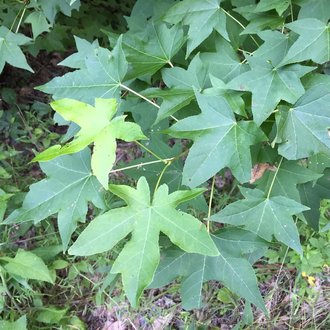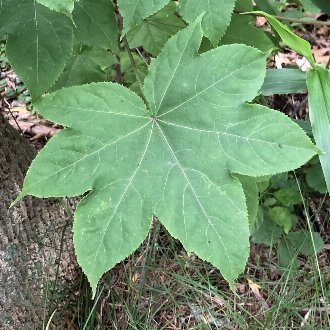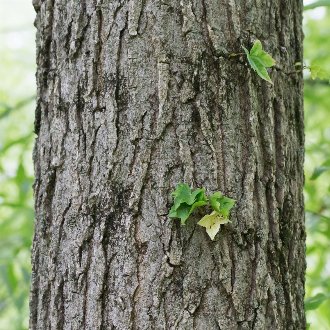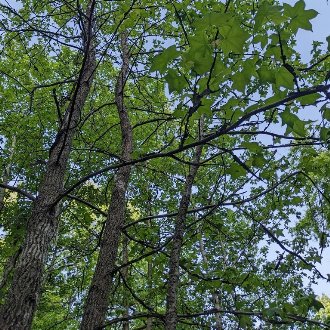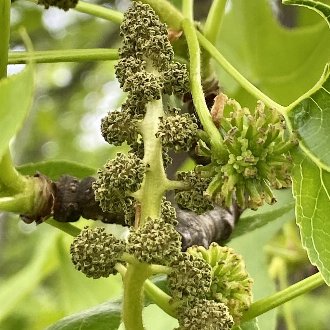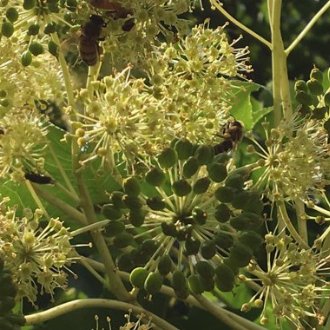American Sweetgum vs Castor-Aralia
These species are sometimes confused, as both have 5-7 lobed leaves with finely-serrated margins, both prefer moist sites, and mature trees of both species have bark with deep ridges and furrows. They are easily distinguished by the castor-aralia's thorns and sparse branching, or by flowers or fruit, and they can also be distinguished by leaf size and shape. Although both plants can occur in landscaping, there is little habitat overlap in the wild: sweetgum ranges farther south and better tolerates nutrient-poor, acidic, and/or poorly-drained soils, whereas castor-aralia ranges farther north, tolerates greater shade, and is more limited to sites with deep, fertile soils.
American Sweetgum (Liquidambar styraciflua) | Castor-Aralia (Kalopanax septemlobus) |
A distinctive tree with star-shaped leaves and hard, spiky fruits. Native to southeastern North America where it tends to be found on moist to wet sites. | An uncommonly cultivated introduced species in North America, someties escaping into the wild; has potential to become invasive, but not widely planted. |
Stems and twigs are narrower and lack thorns; mature twigs are sometimes covered in ridges. Photo © Mason Heberling, CC BY 4.0. | Stems and young twigs are thicker and have thorns. Photo © Summit Metro Parks, CC BY-SA 4.0. |
Leaves are narrower (4.4-16cm or 1.7-6.3 in) and tend to have narrower lobes and less total surface area. Photo © Robb Hannawacker, Public Domain. | Leaves are wider (18-35cm or 7-14in) and fuller, with wider lobes (particularly stout at the base) and greater total surface area. Photo © Lythronax246, CC BY 4.0. |
Bark ridges and furrows are shallower, and ridges are flatter-topped and more plate-like. Trees frequently sprout from the trunk. Photo © Bill Keim, CC BY 4.0. | Bark ridges and furrows are much deeper, with rugged, sharp-topped ridges. Trees rarely sprout from the trunk. Photo © Nina Filippova, CC BY 4.0. |
Trees branch more, and are more typical among similar-sized trees in this regard. Most major side branches themselves branch extensively near their tips. Photo © stephen, CC BY 4.0. | Trees branch little relative to most trees of similar size; trees usually have one central trunk and relatively few, slender side-branches. Side branches themselves branch little or not at all, even near their tips. Photo © Илья Руденко, CC BY 4.0. |
Flowers are inconspicuous and easily overlooked, and are wind-pollinated. Flowers are followed by a spiky ball that opens to distribute seeds in the wind. Flowers relatively early in spring. Photo © Sandy Wolkenberg, CC BY 4.0. | Flowers are showy, occuring in a globe-shaped cluster that attracts insect pollinators, and are followed by a cluster of fruits that turn black when ripe. Flowers in mid-to-late summer. Photo © Plant Image Library, CC BY-SA 2.0. |
References & External Resources
These short lists show only links helpful for ID. For a complete list of references and resources also covering other aspects of ecology, visit the links section of the full article on each plant, which is the first entry here.





